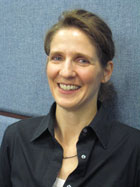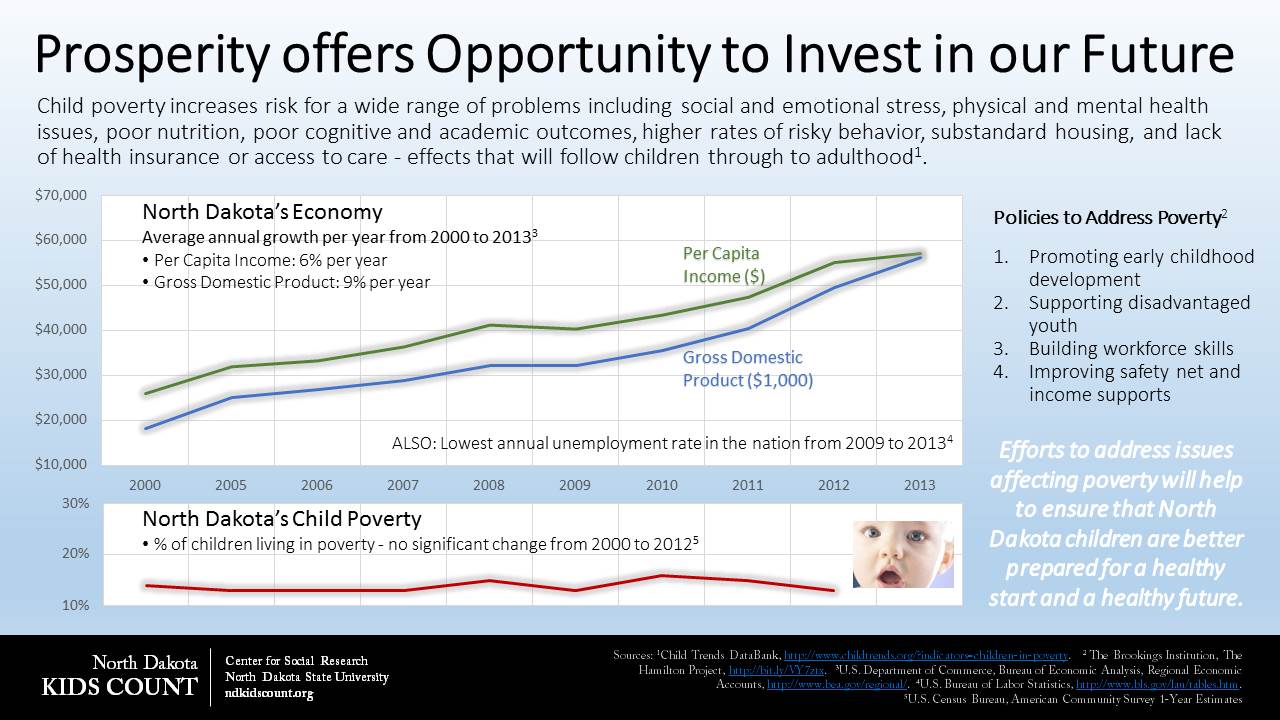ASk A Researcher
August 2014
North Dakota Ranks Well Nationally with Regard to Overall Child Well-Being; However, Substantial Opportunities for Improvement Exist

Karen Olson, program director for North Dakota KIDS COUNT offers some insight into the latest resource available from KIDS COUNT, the 2014 Data Book.
North Dakota’s overall child well-being ranks sixth in the nation according to the Annie E. Casey Foundation’s 25th edition of the KIDS COUNT Data Book, an annual assessment of children’s well-being in the United States. The Data Book provides a portrait of how U.S. children are doing in four key areas of well-being: Economic Well-Being, Family and Community, Education, and Health. States are ranked on 16 indicators of child well-being, four for each key area, that reflect current research regarding the conditions needed for proper child development.
North Dakota experienced improvements in all four areas of child well-being – and ranked no. 1 with regard to the economic well-being of children. This is not too surprising given that North Dakota continues to lead the nation in growth of GDP and per capita income and continues to have the nation’s lowest unemployment rate. Yet, despite these positive measures, many North Dakota children face challenges. For example, North Dakota’s child poverty rate was the lowest among all 50 states in 2012 and has not changed in 12 years, since the year 2000. Currently, 13 percent or 20,000 children live in conditions where their families are unable to afford the basic necessities - and this percentage increases to 50 percent for American Indian children and 40 percent for children living with a single parent. Our current prosperity provides us with a unique opportunity to make investments in the lives of our children to ensure they get the best possible start in life.
The Data Book also helps to identify opportunities for investment - for addressing those challenges. Research suggests that investment is most critical in the early years, birth through age eight, to support families and help young people succeed. Yet, North Dakota has the 5th worst ranking with regard to preschool enrollment among states. High-quality early learning programs for 3- and 4-year-olds can improve school readiness, with the greatest gains accruing to the highest-risk children. Yet, two-thirds of 3- and 4-year-olds in North Dakota do not attend nursery school or preschool. For North Dakota to improve its ranking from 45th to 1st in the nation, it would require enrolling an additional 5,000 children in preschool.
Spending on education and training has the greatest impact early in life. The theory, rooted in well-established science of brain development, is that the first few years of life play a critical role in shaping future emotional, cognitive, and intellectual skills. Children who get consistent, nurturing care are more likely to succeed in school, avoid trouble with the law, and have productive lives in the workforce. According to the Center on the Developing Child at Harvard University, for every dollar invested in early childhood programs, there is a $4-$9 return on the investment. An investment in our young children is an investment in the future economy and workforce of our state. The more we know about our children, the better equipped we are to make smart investments in our future.
Other highlights from the 2014 KIDS COUNT Data Book include:
Economic Well-Being (1st in the nation)
- Strengths: North Dakota continues to rank 1st in the nation with regard to the economic well-being of children. North Dakota has the smallest percentage of children without secure parental employment (19%), the lowest percentage of children in families with a high housing cost burden (16%), the lowest child poverty percentage (13%), and the third lowest rate of idle teens (5%). Three of these four economic well-being measures showed improvement since 2005.
- Challenges and Opportunities: Despite these economic strengths, the percentage of children living in poverty has shown no change over the past seven years - this amidst an economic boom in the state. Currently, about 20,000 North Dakota children are impoverished (i.e., 13%).
Family and Community (4th in the nation)
- Strengths: When compared with other states, children in North Dakota fare well in terms of family and community indicators. North Dakota has the lowest percentage of children living in families where the household head lacks a high school diploma (5%) and the third lowest percentage of children living in single-parent families (28%). In addition, North Dakota saw improvement in the teen birth rate, from 35 births per 1,000 teenage girls in 1990 to 26 per 1,000 in 2012.
- Challenges and Opportunities: The proportion of North Dakota children who live with a single parent has nearly doubled since 1990. Approximately one in four North Dakota children now live with a single parent (28% in 2012, up from 23% in 2005 and 15% in 1990), and these children are about six times more likely to be living in poverty than children living with married parents.
Education (19th in the nation)
- Strengths: Three of the four education indicators showed improvement since 2005: children not attending preschool, eighth graders not proficient in math, and high school students not graduating on time. North Dakota has the fourth lowest percentage of high school students in the nation not graduating on time (9%).
- Challenges and Opportunities: Despite these improvements, two in three fourth graders are not proficient in reading – a proportion that has shown very little change over time. North Dakota also has the fifth worst ranking with regard to preschool enrollment. High-quality early learning programs for 3- and 4-year-olds can improve school readiness, with the greatest gains accruing to the highest-risk children. Yet, two-thirds of 3- and 4-year-olds in North Dakota do not attend nursery school or preschool.
Health (23rd in the nation)
- Strengths: All four health indicators showed improvement since the mid-2000s: the child and teen death rate, children without health insurance, low birth weight babies, and teens who abuse alcohol or drugs.
- Challenges and Opportunities: Though showing some improvement, the child death rate in North Dakota ranks 41st in the nation. With regard to uninsured children, North Dakota dropped in ranking from 19th last year to 30th in this year’s analysis. Although not tracked by the KIDS COUNT Data Book, one growing health problem is childhood weight status. Among North Dakota youth ages 10 to 17, approximately one-third is reported to be overweight or obese (35.8 percent).

